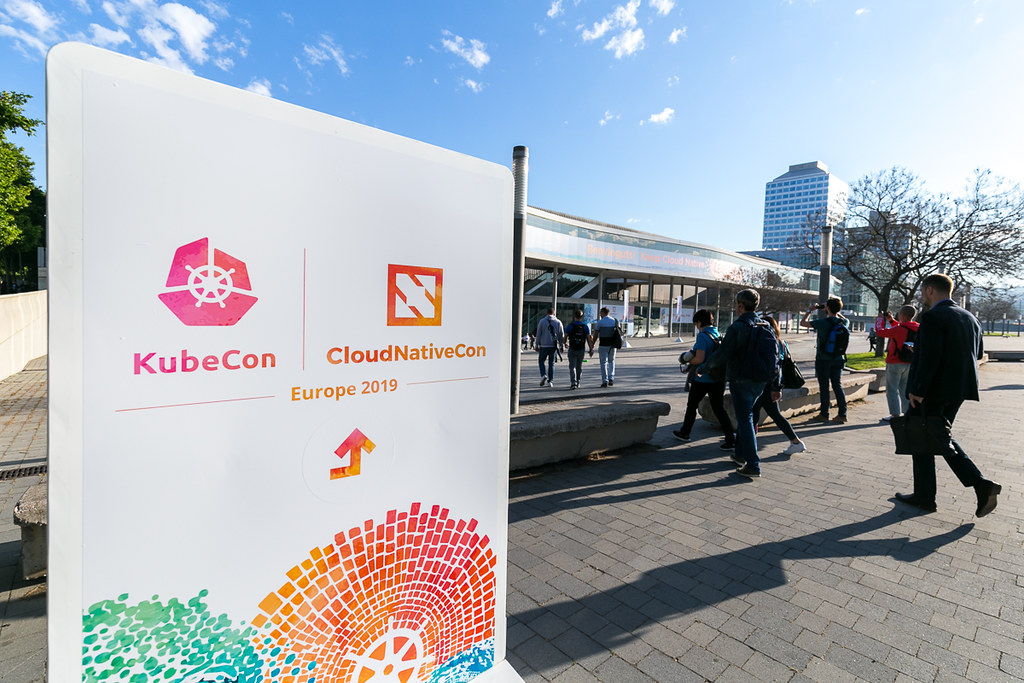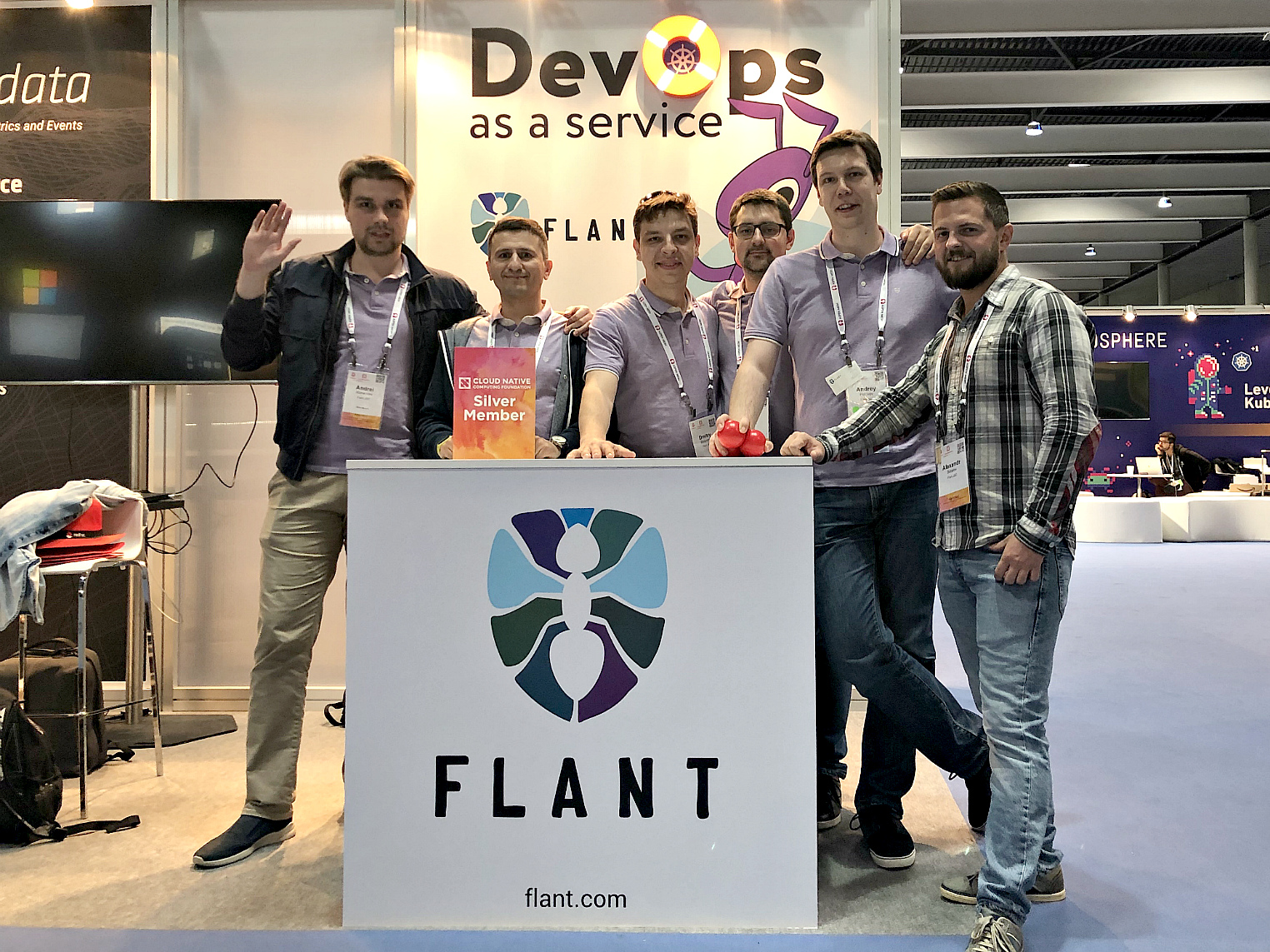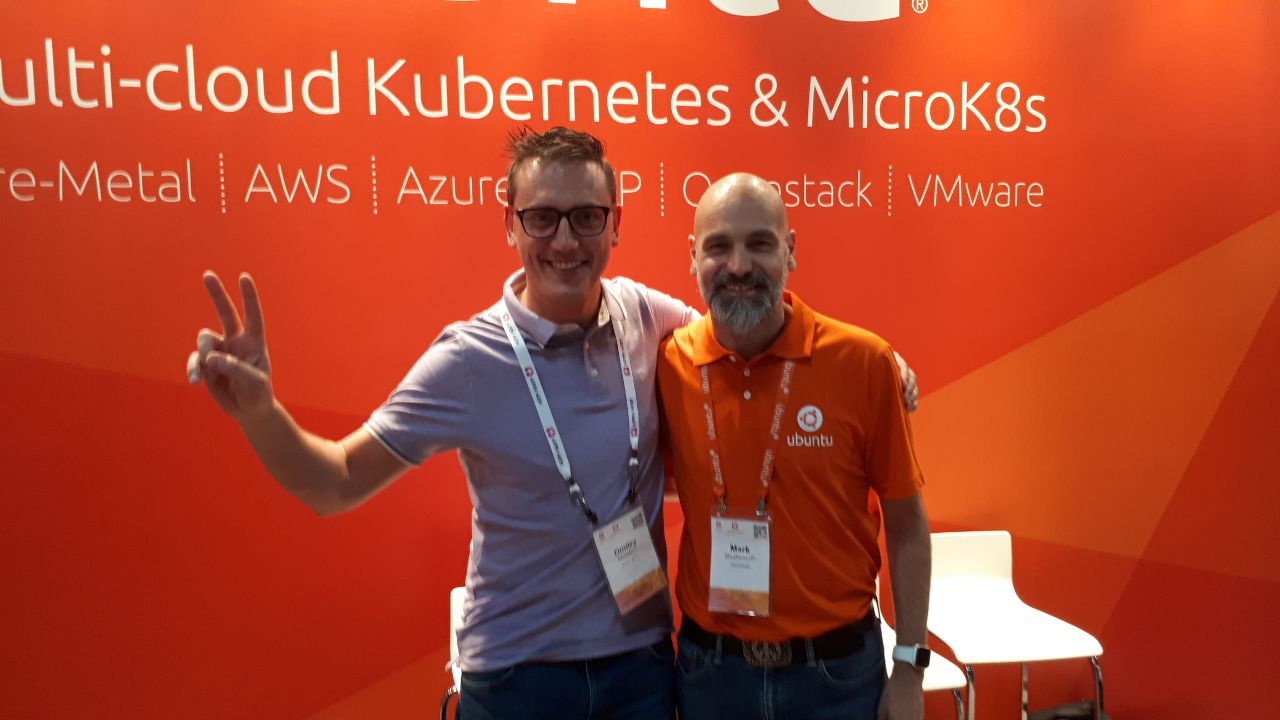KubeCon Europe 2019: How we first visited the main event on Kubernetes
Last week, May 19-23, Barcelona hosted the main European conference on Kubernetes and related technologies, one of the largest Open Source-events in the world - KubeCon + CloudNativeCon Europe 2019 . We took part in it for the first time, becoming a silver sponsor of the event and the first Russian company at KubeCon with its stand. A delegation of six Flants employees was sent to it, and this is what we saw ...

KubeCon is a global event that has already been held in three regions: the United States (since 2015), Europe (from 2016) and China (from 2018). The scale of such events immediately impressive. If at the first European KubeCon (2016 in London) there were about 400 visitors, then last year (2018 in Copenhagen) - already 4300, and now - 7700. (At the last American conference - and even more.)
')
The total duration of KubeCon is 5 days, the first two of which can be considered preparatory (the stands are not yet operational). On the first day (Sunday), a specialized Ceph- Cephalocon event was held. The next day, before 5:00 pm, there are other seminars and meetings on specific technologies, followed by the first events for all conference visitors. And as soon as the doors officially opened, it became clear that there would be not a lot of people, but a lot.
There were also many (about 200) stands of sponsors and partners in the room: from small ones with modest racks to huge lounge-zones by SAP, Microsoft, Google ... However, everything was in line with such scales: a wonderful ventilation and cooling system (there was no feeling of heat, always it was nice and cool), spacious walkways between the stands.

In the stand area, "Flant" was the only company from Russia, and this fact in itself attracted the Russian-speaking public. Many of them already knew about us, and then the conversations began with the phrases: “Oh, did not expect to see you! What are you doing here?"

Found on Twitter
With the other participants in the event, the discussion usually began with questions about who we are and what we do. Many more were affected by the phrase “DevOps as a service” at our booth: “How can this be? DevOps is a culture. How can a culture be made a service? .. ”That was a great reason to talk about what we do and how we carry the notorious culture to customers.

There were a lot of solo DevOps among the visitors to the stand: freelancers and members of small teams. They were interested in our Open Source-arsenal and approach in the spirit of no-bullshit. The response received suggests that the tools we have are well integrated into a variety of work processes and are able to solve immediate problems. The werf and kubedog projects , the various features of deployment in Kubernetes, caused the most attention. Also, people were obviously worried about the issue of managing many clusters: the solution, which we will soon only announce, turned out to be relevant even for freelancers. Engineers of large IT companies such as Google, SAP, IBM listened enthusiastically to the accumulated Open Source-development ...
Representatives of companies from Eastern Europe, as well as Germany and England were most interested in direct services. A separate story - a few Japanese, who admitted that our approach is radically different from what is offered there. Potential clients were interested in the approach to supporting the turnkey infrastructure, experience and readiness to adapt flexibly to customer requirements.
We also met with companies of a similar profile of activity from different countries: some approached us, and some approached us. Sharing our experience with two of them, we discussed the two sides' contributions to Open Source and the possibilities for further interaction - time will tell what will come of it.
If we talk about discussions at the stand as a whole, then personally it was very interesting for me to hear about new projects and ideas. In particular, I recommend paying attention to the garden (development orchestrator for Kubernetes) and conprof (continuous profiling, working with Prometheus and not only): their demos looked promising, and the authors create with noticeable enthusiasm.
Finally, I note that there were no language problems: everyone had a decent level of English. If some nuances emerged, then phones, facial expressions and gestures were easily connected. Obviously, cloud native administrators do not work from the basements of the parent houses .
KubeCon participants played more expensive toys from their stands than we used to see at Russian conferences. Not to mention the main sponsors, who could boast of huge TVs and other attractive hummers ... On Tuesday evening, a special 2 hours were allocated for the drawing of numerous prizes - then there were a lot of people, and the atmosphere of the holiday was clearly felt.
More entertaining, however, for me, was the very movement of the largest companies to the Open Source community. Even understanding their commercial motives (among other things), five years ago it was impossible to imagine that everything that the representatives of companies like Microsoft and Oracle talk about on the stand and in the reports, would concern Open Source products.
Among recognizable celebrities, for example, Mark Shuttleworth was met:

Our technical director Dmitry Stolyarov and Canonical founder Mark Shuttleworth
When I thanked him for Ubuntu, because this is my first distribution and the beginning of my acquaintance with Linux, he replied that he needed to thank not him, but “get those guys in orange T-shirts” hinting at all Canonical employees.
I also talked with pleasure to:
I brought the Beluga to the latter because he helped me a lot with CNCF Slack with questions on the Kubernetes API. Here he is trying to open it (in the end, opened in three ...):

James Munnelly examines his gift

We communicate with Brian Brazil - the main maintainer of Prometheus
Monday at KubeCon is officially dedicated to the so-called preliminary (pre-conference) events and other pressing issues (such as the preparation of stands). It turned out to be more free for us, and therefore we decided to visit the Continuous Delivery Summit , organized by the recently created CDF foundation (we already wrote about it here ).
It was interesting to hear about the union of various forces involved in the development of products and approaches to the organization of continuous delivery. It was possible to see the creator of Jenkins, as well as listen to a report about Jenkins X (we also wrote about him).
Personally, I was even more fascinated by the story of another project of this foundation - Tekton . The attempt to standardize approaches to CD in Kubernetes clearly deserves our attention. In particular, they bribe the possibilities of Tekton's flexible insertion into their pipelines and werf connections through the API. By promoting Tekton as a standard, its authors (Google) want to reduce fragmentation of utilities for CI / CD, and we agree with them.
The total number of event reports, which included both “regular” (half-hour) speeches, and key (keynote), and short sessions (lightning talks), and numerous events for communities (updates from projects, developers and users meetings, presentations of new Maintainers), measured in hundreds . The extent of what is happening (more precisely, what has already happened) can be assessed on the conference website .

Report in the main hall of KubeCon Europe 2019. Photos from the organizers
Since we were all constantly involved in the stand area, there was practically no time to visit the main streams with reports. However, you shouldn’t get upset: CNCF organization has already published videos of event reports for everyone. They can be found on YouTube .
On the last day, KubeCon was awaiting visitors for a final party lasting about 3 hours. On it, everyone was taken to Poble Espanyol - a Spanish castle, which was made for the 1988 Olympics. 7 thousand IT specialists were fed, fed and entertained in its walls - it became clear how many people came from all over the world. Perhaps even too much:

But the view is amazing:

European KubeCon is an event that is remembered for its scale, high level of organization, and orientation to support and develop a huge open source community of people who are truly passionate about their work. We still have to listen to the keynote speeches from the conference, but from the experience of the recordings available from previous KubeCons, their level and relevance is unlikely to cause questions.
We have made for ourselves a series of conclusions on our own participation. Mini-presentations of our open source projects are an excellent reason to “start a conversation” with the wider community. It was not a discovery that even more useful in this sense would be a speech with a full report (by the way, the competition for reports for KubeConEU'19 amounted to 7 applications for one available place). We also understood which presentations would be useful and what should be written on the stand itself in order to remove some of the questions and quickly move on to a more detailed discussion.
Photos from KubeCon from the organizers can be found in this Flickr album .
UPDATE (June 4): CNCF has sent official statistics for the event. Here she is:

PS For help in preparing the material, I thank colleague Vladimir Kramarenko ( kramarama ).
Read also in our blog:

The event as a whole
KubeCon is a global event that has already been held in three regions: the United States (since 2015), Europe (from 2016) and China (from 2018). The scale of such events immediately impressive. If at the first European KubeCon (2016 in London) there were about 400 visitors, then last year (2018 in Copenhagen) - already 4300, and now - 7700. (At the last American conference - and even more.)
')
The total duration of KubeCon is 5 days, the first two of which can be considered preparatory (the stands are not yet operational). On the first day (Sunday), a specialized Ceph- Cephalocon event was held. The next day, before 5:00 pm, there are other seminars and meetings on specific technologies, followed by the first events for all conference visitors. And as soon as the doors officially opened, it became clear that there would be not a lot of people, but a lot.
There were also many (about 200) stands of sponsors and partners in the room: from small ones with modest racks to huge lounge-zones by SAP, Microsoft, Google ... However, everything was in line with such scales: a wonderful ventilation and cooling system (there was no feeling of heat, always it was nice and cool), spacious walkways between the stands.

Near our booth
In the stand area, "Flant" was the only company from Russia, and this fact in itself attracted the Russian-speaking public. Many of them already knew about us, and then the conversations began with the phrases: “Oh, did not expect to see you! What are you doing here?"

Found on Twitter
With the other participants in the event, the discussion usually began with questions about who we are and what we do. Many more were affected by the phrase “DevOps as a service” at our booth: “How can this be? DevOps is a culture. How can a culture be made a service? .. ”That was a great reason to talk about what we do and how we carry the notorious culture to customers.

There were a lot of solo DevOps among the visitors to the stand: freelancers and members of small teams. They were interested in our Open Source-arsenal and approach in the spirit of no-bullshit. The response received suggests that the tools we have are well integrated into a variety of work processes and are able to solve immediate problems. The werf and kubedog projects , the various features of deployment in Kubernetes, caused the most attention. Also, people were obviously worried about the issue of managing many clusters: the solution, which we will soon only announce, turned out to be relevant even for freelancers. Engineers of large IT companies such as Google, SAP, IBM listened enthusiastically to the accumulated Open Source-development ...
Representatives of companies from Eastern Europe, as well as Germany and England were most interested in direct services. A separate story - a few Japanese, who admitted that our approach is radically different from what is offered there. Potential clients were interested in the approach to supporting the turnkey infrastructure, experience and readiness to adapt flexibly to customer requirements.
We also met with companies of a similar profile of activity from different countries: some approached us, and some approached us. Sharing our experience with two of them, we discussed the two sides' contributions to Open Source and the possibilities for further interaction - time will tell what will come of it.
If we talk about discussions at the stand as a whole, then personally it was very interesting for me to hear about new projects and ideas. In particular, I recommend paying attention to the garden (development orchestrator for Kubernetes) and conprof (continuous profiling, working with Prometheus and not only): their demos looked promising, and the authors create with noticeable enthusiasm.
Finally, I note that there were no language problems: everyone had a decent level of English. If some nuances emerged, then phones, facial expressions and gestures were easily connected. Obviously, cloud native administrators do not work from the basements of the parent houses .
Other stands and interesting people
KubeCon participants played more expensive toys from their stands than we used to see at Russian conferences. Not to mention the main sponsors, who could boast of huge TVs and other attractive hummers ... On Tuesday evening, a special 2 hours were allocated for the drawing of numerous prizes - then there were a lot of people, and the atmosphere of the holiday was clearly felt.
More entertaining, however, for me, was the very movement of the largest companies to the Open Source community. Even understanding their commercial motives (among other things), five years ago it was impossible to imagine that everything that the representatives of companies like Microsoft and Oracle talk about on the stand and in the reports, would concern Open Source products.
Among recognizable celebrities, for example, Mark Shuttleworth was met:

Our technical director Dmitry Stolyarov and Canonical founder Mark Shuttleworth
When I thanked him for Ubuntu, because this is my first distribution and the beginning of my acquaintance with Linux, he replied that he needed to thank not him, but “get those guys in orange T-shirts” hinting at all Canonical employees.
I also talked with pleasure to:
- the Ubuntu team that deals with the Juju project;
- SAP team that is engaged in the project Gardener ;
- prometheus-operator and kube-state-metrics maintener - Frederic Branczyk;
- cert-manager - creator and maintainer - James Munnelly.
I brought the Beluga to the latter because he helped me a lot with CNCF Slack with questions on the Kubernetes API. Here he is trying to open it (in the end, opened in three ...):

James Munnelly examines his gift

We communicate with Brian Brazil - the main maintainer of Prometheus
Reports, meetings and other activities
Monday at KubeCon is officially dedicated to the so-called preliminary (pre-conference) events and other pressing issues (such as the preparation of stands). It turned out to be more free for us, and therefore we decided to visit the Continuous Delivery Summit , organized by the recently created CDF foundation (we already wrote about it here ).
It was interesting to hear about the union of various forces involved in the development of products and approaches to the organization of continuous delivery. It was possible to see the creator of Jenkins, as well as listen to a report about Jenkins X (we also wrote about him).
Personally, I was even more fascinated by the story of another project of this foundation - Tekton . The attempt to standardize approaches to CD in Kubernetes clearly deserves our attention. In particular, they bribe the possibilities of Tekton's flexible insertion into their pipelines and werf connections through the API. By promoting Tekton as a standard, its authors (Google) want to reduce fragmentation of utilities for CI / CD, and we agree with them.
The total number of event reports, which included both “regular” (half-hour) speeches, and key (keynote), and short sessions (lightning talks), and numerous events for communities (updates from projects, developers and users meetings, presentations of new Maintainers), measured in hundreds . The extent of what is happening (more precisely, what has already happened) can be assessed on the conference website .

Report in the main hall of KubeCon Europe 2019. Photos from the organizers
Since we were all constantly involved in the stand area, there was practically no time to visit the main streams with reports. However, you shouldn’t get upset: CNCF organization has already published videos of event reports for everyone. They can be found on YouTube .
On the last day, KubeCon was awaiting visitors for a final party lasting about 3 hours. On it, everyone was taken to Poble Espanyol - a Spanish castle, which was made for the 1988 Olympics. 7 thousand IT specialists were fed, fed and entertained in its walls - it became clear how many people came from all over the world. Perhaps even too much:

But the view is amazing:

Conclusion
European KubeCon is an event that is remembered for its scale, high level of organization, and orientation to support and develop a huge open source community of people who are truly passionate about their work. We still have to listen to the keynote speeches from the conference, but from the experience of the recordings available from previous KubeCons, their level and relevance is unlikely to cause questions.
We have made for ourselves a series of conclusions on our own participation. Mini-presentations of our open source projects are an excellent reason to “start a conversation” with the wider community. It was not a discovery that even more useful in this sense would be a speech with a full report (by the way, the competition for reports for KubeConEU'19 amounted to 7 applications for one available place). We also understood which presentations would be useful and what should be written on the stand itself in order to remove some of the questions and quickly move on to a more detailed discussion.
Photos from KubeCon from the organizers can be found in this Flickr album .
UPDATE (June 4): CNCF has sent official statistics for the event. Here she is:

PS For help in preparing the material, I thank colleague Vladimir Kramarenko ( kramarama ).
Pps
Read also in our blog:
Source: https://habr.com/ru/post/454184/
All Articles